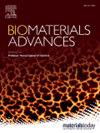The aluminum nanoparticle-encircled SQ-in-water emulsions (ANSWE) as a vaccine adjuvant-delivery system (VADS) for developing robust mucosal subunit vaccines
IF 5.5
2区 医学
Q2 MATERIALS SCIENCE, BIOMATERIALS
Materials Science & Engineering C-Materials for Biological Applications
Pub Date : 2024-10-23
DOI:10.1016/j.bioadv.2024.214076
引用次数: 0
Abstract
The aluminum nanoparticle-encircled squalene (SQ)-in-water emulsions (ANSWE) were engineered as a VADS (vaccine adjuvant-delivery system) using a simple procedure for carrying antigens (Ag) to develop subunit vaccines. In vitro, due to possessing the synergistic adjuvanticity of both AN and SQ, ANSWE were efficiently taken up by APC (antigen-presenting cells) and triggered them to mature and make extra ROS (reactive oxygen species) and multiple cytokines, such as IL-12, IL-1β and IFN-β, which favor balanced Th1/Th2 immunoresponses. Within APC, ANSWE managed lysosome escape and consequently enhanced proteasome activities to facilitate Ag cross-presentation. Mice given twice ovalbumin-ANSWE via intrapulmonary vaccination (IPV) produced high levels of anti-Ag antibodies as well as cytotoxic T lymphocytes, which efficiently erased cells bearing cognate Ag. Thus, ANSWE as a potent VADS may be feasible for developing mucosal subunit vaccines that can elicit comprehensive immunity against infectious diseases, including especially the respiratory infections, and even aggressive cancers.

将纳米铝粒子包裹的水包水 SQ 乳剂 (ANSWE) 作为疫苗佐剂递送系统 (VADS),用于开发强效粘膜亚单位疫苗
利用携带抗原(Ag)的简单程序将铝纳米粒子包裹角鲨烯(SQ)的水乳剂(ANSWE)设计成疫苗佐剂递送系统(VADS),以开发亚单位疫苗。在体外,由于 ANSWE 具有 AN 和 SQ 的协同佐剂作用,因此能被抗原递呈细胞(APC)有效吸收,并促使它们成熟,产生额外的 ROS(活性氧)和多种细胞因子,如 IL-12、IL-1β 和 IFN-β,从而促进 Th1/Th2 免疫反应的平衡。在APC内,ANSWE可控制溶酶体逃逸,从而增强蛋白酶体的活性,促进抗体的交叉呈递。通过肺内接种(IPV)两次卵清蛋白-ANSWE的小鼠产生了高水平的抗Ag抗体和细胞毒性T淋巴细胞,它们能有效清除携带同源Ag的细胞。因此,ANSWE 作为一种强效的 VADS,可用于开发粘膜亚单位疫苗,从而获得针对传染病(尤其是呼吸道感染)甚至侵袭性癌症的全面免疫力。
本文章由计算机程序翻译,如有差异,请以英文原文为准。
求助全文
约1分钟内获得全文
求助全文
来源期刊
CiteScore
17.80
自引率
0.00%
发文量
501
审稿时长
27 days
期刊介绍:
Biomaterials Advances, previously known as Materials Science and Engineering: C-Materials for Biological Applications (P-ISSN: 0928-4931, E-ISSN: 1873-0191). Includes topics at the interface of the biomedical sciences and materials engineering. These topics include:
• Bioinspired and biomimetic materials for medical applications
• Materials of biological origin for medical applications
• Materials for "active" medical applications
• Self-assembling and self-healing materials for medical applications
• "Smart" (i.e., stimulus-response) materials for medical applications
• Ceramic, metallic, polymeric, and composite materials for medical applications
• Materials for in vivo sensing
• Materials for in vivo imaging
• Materials for delivery of pharmacologic agents and vaccines
• Novel approaches for characterizing and modeling materials for medical applications
Manuscripts on biological topics without a materials science component, or manuscripts on materials science without biological applications, will not be considered for publication in Materials Science and Engineering C. New submissions are first assessed for language, scope and originality (plagiarism check) and can be desk rejected before review if they need English language improvements, are out of scope or present excessive duplication with published sources.
Biomaterials Advances sits within Elsevier''s biomaterials science portfolio alongside Biomaterials, Materials Today Bio and Biomaterials and Biosystems. As part of the broader Materials Today family, Biomaterials Advances offers authors rigorous peer review, rapid decisions, and high visibility. We look forward to receiving your submissions!

 求助内容:
求助内容: 应助结果提醒方式:
应助结果提醒方式:


